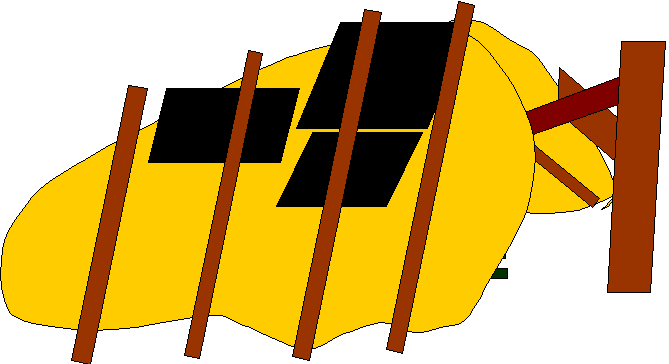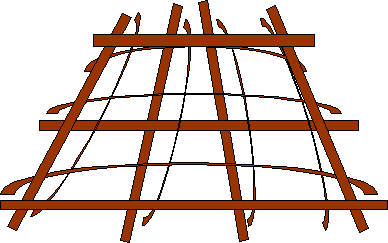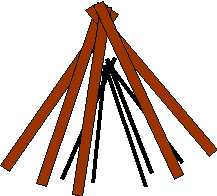

[Title]
[text TOC]
[image TOC]
[Site Search]
 [Donation]
[Donation]
 |
Wilderness Survival |
 |

For other activities, see the Activities Chapter.
If you don't think that sleeping out in the woods with all the bugs and animals or eating grubs and worms would be fun, then perhaps you should learn some techniques for not getting lost and being put in a wilderness survival situation. Learn more about Staying Found.
As you can see by the amount of information below, this is one of my favorite subjects. One reason I am so interested in this is that I have such a bad sense of direction, I know that some day I may very well need to know everything here.
Your survival in a wilderness situation will depend on what you know and how you use it. Any wilderness survival situation can be very dangerous. It is important to remember the priorities. Preparing for it can be fun and should be educational. Many games can be made involving a variety of situations and a list of available items. It's also a great challenge trying to see how many items you can stuff into a small survival kit container.
It is important to know not only the information, but why it is so and what conditions can change things. The Boy Scout merit badge book on wilderness survival is a good resource. Tom Brown's field guide to wilderness survival is excellent. There are also many other books and Internet sites that cover the topic.
Children are especially at risk because behavior in a survival situation goes against how they normally react. Remember that they are not as knowledgeable of or experienced with the wilderness. It is very important that they be taught what to do and why. At least discuss with them the first priority below - S. T. O. P.
Survival will be a lot easier if you have the knowledge, skills, and the equipment. Practice your skills frequently (see the practice activities below). It is one thing to "know" the information and skills and quite another to be able to do them in real situations. Consider how hard it can be to start a fire, how about in windy weather, how about after a hard rain, how about with only one match, how about with flint and steel. Now think of a worse case scenario - at night, in the wind, after a rain, with only your knife and whatever else you can find.
The chances of you finding your way out are very small. So your responsibilities are to stay alive and make it easier for searchers to find you. Make yourself as comfortable as you can.
The information below assumes that the prevailing wind is from the west, which is true for most of the United States. This means that storms will come from the west. Local terrain and conditions can vary so use your best judgment.
Below is a list of priorities. I carry a copy in my survival kit. One does not always think clearly in emergency situations and having a small piece of paper with the priority listed could help. The priorities are based on how quickly you could die without help. If you are seriously injured, you may only last a few minutes. Without shelter, you could die from exposure in a few hours if it is cold and wet. You can survive without water for at least a couple days, and without food for at least a week.
The list is not meant to be a hard and fast set of rules. Each situation will be different depending on the weather, if you are injured, what type of area you are in, ...

Wilderness Survival Priority List
- Positive Mental Attitude - The most important item you have is your brain
- Stop - Hug a tree. Relax. Seek safety (from weather, water, animals), shelter (from cold, rain, heat), visibility (so you can see and be seen). A stationary person is easier to find than a moving one.
- Think - What went wrong? Can I help myself? Can I help others find me? Don't make hasty decisions.
- Observe - Am I hurt? What do I have that may help me? What's the weather going to do? What natural resources are available?
- Pray/Plan - Set up camp, make a fire.
- First Aid
- Take care of any serious problems.
- Shelter - protection from heat, cold, rain, sun
- Large plastic bag, emergency bag/blanket, poncho, found materials
- Fire - warmth, security, signaling, ...
- Signaling - mark X, signal in 3's
- Don't yell it doesn't carry far and is tiring - whistle instead
- Smoke (can be seen for miles), whistle (carries in all directions), flag/bandana, mirror (single direction for miles), flashlight (single direction)
- Water - you can survive a few days without it
- Boil - 5 minutes max
- 2 drops chlorine per quart (double if water is cloudy) - let set for 30 minutes
- 5 drops iodine per quart (double if water is cloudy) - let set for 30 minutes
- Food - you can survive a week or more without it
- All healthy mammals, birds, insects are edible
- Anything seen eaten by rabbits, rodents, beavers, squirrels, raccoons, NOT birds
- No plants with soapy, bitter, acid, burning taste; take a small taste, wait for 5 minutes; use caution
- No plants with milky saps, or sickly looking; cook

Thoughts on Priorities
- Positive Mental Attitude
- The natural reaction to being lost is fear and panic; instead relax and think of it as a challenge or an opportunity.
- Think about your situation. Is it dangerous or life threatening? What's the possibility of getting out on your own (be honest)? Where is help located? How far is it? Are there barriers (rivers, ravines, cliffs)? How long before someone misses you and starts searching? Can you sustain yourself until help arrives? When in doubt, STAY PUT.
- Be comforted in knowing that others have survived much worse situations with much less equipment and knowledge.
- Make the best of the situation realizing that you may WANT a sleeping bag, but all you NEED is a pile of leaves.
- Determine what you need, improvise the best you can in a way that takes the least amount of time, energy, and resources.
- You have no choice but to do something for yourself.
- Don't complain (no one will hear you anyway), keep busy (you'll be less miserable), make improvements (better shelter, backrest or chair, woven fiber sleeping bag, trap, tools).
- Live moment to moment - survive this moment, enjoy your success, then prepare for the next moment.
- Prioritize - what do you need the most first aid, shelter, fire, signal, water? Consider how long it might take to build a shelter or fire.
- Be curious, explore nearby. Observe your surroundings - look for high places where you could be seen; natural resources for protection from weather, shelter or fire; water.
- Seek a harmony with nature - you can't stop a thunderstorm, but you can bend like the grass or seek shelter like the animals.
- Develop survivor pride! Don't ever give up!
- Conserve energy, strength, fluids, and heat. Move as little as possible; avoid exercise, work, shivering and sweating. Use your head not your feet.
- Your enemies to a positive mental attitude are: cold, heat, thirst, hunger, tired, sick, hurt, boredom, and loneliness. Any one of these can make you think irrationally and make bad decisions.
- Your friends are: knowledge, experience, improvising, adapting, staying calm, optimistic attitude, patience.
- Practice Activities - How do you react to change? Do you make the best of it or do you complain or act passively? Next time you react negatively to change, sit down and make a list of the positives. Try to make do with less gear on campouts - stretch your comfort level. Expose yourself to uncomfortable situations. Learn how to deal with adverse weather. Make a survival kit.
- First Aid
- Bleeding - weakness, shock;
Apply pressure, elevate cut above your heart, clean out as best you can and cover
- Dehydration - poor thinking;
Drinks fluids, stay in the shade
- Hypothermia - fatigue, shivering, uncoordinated, blue skin, poor thinking;
Stay out of wind and rain, don't sit on the ground/rock sit on leaves, avoid sweating, eat and drink
- Practice Activities - While on a hike, pretend one of the group comes down with one of the above ailments, how would you solve it?
- Shelter
- Location, location, location. A good shelter in a bad location is a bad shelter.
- Look for natural covers like beneath the bottom branches of a tree or a rock overhang.
- Protect yourself from wind, rain, sun, dead limbs, and rock falls.
- Not in a low spot where water puddles. Not next to water where there's a chance of flooding.
- Away from fire hazards - you will have a fire nearby.
- Away from ants, animal dens, poisonous plants, and sharp rocks.
- Next to a clearing so more easily seen from the air, on north side in winter or rainy conditions for more sun, on south side in summer for protection from sun.
- Plenty of resources nearby - building materials (frame work, insulation, roofing), water, plants, and animals.
- Make use of what nature gives you - caves, logs, and rocks.
- Construction
- Height - a little taller than you are sitting. Look for crock in tree this height.
- Length about 2 times your height (sleep area plus work area, storage area). Work area can be added on later. Look for a long, straight, and strong branch.
- Opening on east side away from most storms.

- Place ribs wide enough that you fit easily inside.

- Place horizontal sticks; they can be woven. These help hold the insulation out of the interior.

- Pile light, airy, dry debris like leaves and grass in a dome shape. You need about 2 feet thick to keep you warm to freezing. Steeper gives better rain protection, more insulation makes it warmer. You can use your arm to measure its depth.

- Stack hunks of bark or moss or anything else you can find to use a shingles. Plastic works great if you have it.
- Pile green or wet shrubs (for fire protection) on top of everything to hold it in place in case there is a strong wind.

- Stuff interior with the driest, fluffiest leaves (cattails or grass). Mat it down and stuff it full again.
- Make a pile in the work area to cover your head or add to cold spots during the night.
- Make another pile just outside the opening to plug up the opening.
- Other ideas:
- Make a door out of woven sticks, leaves, and arched woven sticks.

- Stuff clothes with dry grasses.
- You can use rocks if branches and leaves are in short supply. Close up openings with mixture of half mud and half dry grass.
- Cordage - dogbane, milkweed, stinging nettle, cattail - Dry, crush with flat rock, open stem and remove strands. Hold one end in one hand. With your other hand roll against pant leg repeatedly in one direction. Take the middle in your mouth bring ends together. It will twist together naturally.
- Practice Activities - While hiking point out good natural shelters (list advantages and disadvantages) and other resources. Identify plants for cordage and make a rope.
- Fire - Fire is magical, it is such a powerful tool. First, it helps maintain a positive mental attitude, keeps you in one place, provides warmth, smoke for signaling, and heat for purifying water, cooking and making tools. Don't abuse it, but respect it. Keep fires small so you can keep them under control.
- Watch at all times.
- Choose a location that is dry and out of the wind.
- Dig a shallow pit or dish to protect it from the wind. Pit should be at least 6 feet to the east of the shelter.
- Clear an area at least 4 feet around the pit.
- Build a rock wall about 2 feet high in a "C" shape on east side of pit to reflect heat back toward shelter. Rocks should be a couple feet back from the pit. If the wind is strong, use the wall to block it while starting the fire. Don't use rocks that are wet as they may explode when heated.
- Collect enough fuel to last all night. It should be dry. Check places that get sun - south side of hill, away from direction of storms. Don't get wood from the ground - it will be damp. It should break (indicating it is dead) and not bend, and be dry to the touch. You can dry small fuel inside your clothing, but not next to your skin. Look for dry wood inside dead and rotten logs.
- Tinder should be very dry. Use the fibrous inner bark (cedar) or seeds (cattails). Loosen and separate fibers.
- Twigs - less than 1/4" in diameter, dry. Pine needles work well, also.
- Sticks
- Logs
- Make a tipi shape out of the twigs with sticks on the outside. Leave an opening for placing the burning tinder.

- Fire by Friction with a bow drill is probably the easiest (unless you have matches or a lighter).
- Parts

- Bow - 1/2" in diameter and 2 1/2' to 3' long and slightly curved; with shoelace, leather, or sinew - you will need to readjust the tension
- Spindle (3/4 - 1" x 8" round) and fireboard (1/2" x 12" x 3" flat) - made from the same wood like cottonwood, willow, cedar, sycamore; not oak (too hard) or pine (resinous)
- Handhold - oak branch or rock
- Construction (assumes you are right handed)

- Make starter holes in fireboard and handhold as shown.
- Kneel with your right knee on the ground and left foot on the fireboard.
- Wrap the bow's cord once around the spindle. It should be tight enough that it feels like it wants to untwist.
- Lean over and rest your chest on your left thigh.
- Your left arm should be against your lower leg holding the spindle perpendicular to the fireboard.
- With the bow in your right hand, keep your right arm straight.
- Move the bow slowly back and forth, level to the ground, using long strokes.
- Increase the downward pressure.
- Stop after a good round impression has been made in the fireboard.
- Cut a notch into the side of the board but not all the way to the center of the impression.
- Lubricate the top of the spindle with oil from your nose or hair or the oil from a nut or acorn. Pine pitch will also work, but don't use water.
- Making a fire - it takes lots of practice
- Make sure the surroundings are dry or at least work on a dry piece of bark.
- Fluff up the tinder and form it into a bird's nest.
- Place the tinder directly under notch.
- Using the position described above, start moving the bow back and forth with long strokes.
- Start slow and then apply more downward pressure and increase speed.
- As it starts to smoke you'll see a brown powder forming.
- If the bow's cord becomes loose allowing the spindle to slip, stop and tighten up the cord.
- Push harder and move faster.
- When you see a coal glowing, stop, and carefully place it in the center of the bird's nest.
- Hold the bird's nest up in your hands and gently blow on the coal.
- When the tinder catches, place it inside the tipi and blow or fan it until it catches.
- Fire by Sparks
- Flint and steel or magnesium (more widely available).
- Place a cotton ball or dryer lint very close to sparker.
- Cotton/dryer lint will burn for a few seconds on its own. Putting a little Vaseline or candle wax on the cotton ball/dryer lint will make it burn for a few minutes.
- Other things that burn well
- Alcohol (be careful as the flame is invisible)
- Trick birthday candles
- Hand Sanitizer (contain lots of alcohol - beware of invisible flame)
- Potato chips
- Heat dry rocks in a fire for boiling water and cooking food.
- Large hot rocks can be buried 6 inches under ground inside shelter to keep it warmer.
- Make a spoon or bowl starting with a dry stick or log. Choose a piece of wood without cracks or knots and that doesn't pop a lot in the fire. Place burning coals on top, hold them in place with a stick, and blow slow and steady on them. Scrap out burnt area. Repeat until desired shape.
- Practice Activities - What tinder is available? See which works best. Start campfires with fire by friction. Make a spoon or bowl . Make a fire starting kit.
- Signaling
- To make a fire smoke, build it larger and add green or wet leaves.
- Whistling carries further and takes less energy than shouting - Straw and Grass Whistles and Wooden Whistle.
- Practice Activities - Make a whistle from just a blade of grass.
- Water
- Clean/Safe Sources
- Rain before it hits the ground - collect in a plastic sheet.
- Dew - collect with a cloth early in the morning
- Solar Still - Dig a hole 4' wide by 3' deep, put a cup in the bottom with a tube, cover hole with plastic secured with dirt and rocks, place small rock in the middle. You can put water near hole or vegetation in hole. Will also collect rainwater.

- Prickly pear cactus
- Grape vines (root is poisonous, make sure it's not poison ivy)
- Thistle
- Sycamore
- Other sources need to be treated with iodine or chlorine or filtered or boiled to kill bacteria, ...
- Water flows downhill, so look for it in low areas.
- Polluted water can cause severe diarrhea and nausea; both can be deadly in the wilderness.
- Don't take chances; there may be a dead animal or chemicals from farms upstream.
- Best sources are fast moving, clear streams with healthy plants and animals in and around.
- Ponds and lakes are more polluted; look for the stream that feeds it.
- Filter with cloth or sand.
- Boil for 5 minutes - use hot rocks and tongs made from bent green branch.
- The colder and cloudier the water is the more time and iodine or chlorine you must add to kill the nasties.
- When using chlorine (bleach), make sure the only ingredient is hypochlorite and there are no other soaps or scents added. Add 2 drops per quart and let it sit for 30 minutes. If there isn't a faint odor of chlorine, repeat treatment.
- If only polluted or salty water is available, boil it and catch the steam with a piece of plastic or aluminum foil or cloth.
- Practice Activities - Identify water sources while hiking. Boil water with fire-heated rocks.
- Food
- WARNING: Do not eat ANY plant or animal unless you are absolutely positive what it is. Learn from an expert. Go with an expert into the field and learn to identify edible as well as poisonous plants. Many poisonous plants look similar to edible plants. Learn how to prepare and cook them.
- It will most likely take more energy to get food than you will gain from it. Seek only easily acquired food. Eat small amounts to avoid an upset stomach. Diarrhea or vomiting will leave you worse off.
- Grass - no grass is poisonous, but don't eat too much (especially mature stems) as it is hard to digest. Choose tender young shoots; cooking for several minutes will help. Brown or green grass seeds should be toasted. Do not eat purple or black seeds as they contain a poisonous fungus.
- Cattail - young shoots, roots; seed (tinder), leaves (insulation, weaving)
- Acorns - boil in several changes of water to remove bitter taste.
- Pine needles - finely chop needles and boil to make a tea.
- Prickly Pear Cactus - peeled pads, fruit; be careful of spines.
- Yucca hearts
- Mesquite beans
- Dandelion
- Sunflower
- Grass Seeds
- Insects - remove stingers, legs, hard shells, and wings. Look for them in moist shady areas like in rotting logs and under bark and leaves.
- Practice Activities - Identify edible plants then prepare and eat them. Make oil from nuts. Eat prickly pear cactus which is sold in some groceries as jopales. Try some of these less intense fun cooking ideas.

Why might you include a snack in a survival kit? Contrary to what you might think, it is not for it's value as food (Priority #7), but for helping you with a positive mental attitude (Priority #1). If you have something to snack on, you are more likely to sit down and think about your situation. People usually put food much higher on the priority list maybe because they don't know how to obtain it in the wild. Securing food from the wilderness may be the most difficult of the priorities above (along with fire building) because it is the least practiced. Having a small snack on hand can give you a sense of security.

Here is a test. You are in a survival situation and you only have one match. In your pockets, you find a candle, some string, pocket lint, and a paper napkin. Which do you light first?
It's a trick question - light the match first!
OK, all this said about surviving in the wilderness, the best thing is to stay found. Before you go make a plan. Where will you start and end? When will you leave and return? What equipment will you be taking? Once you have a plan, leave it with someone along with contact information. Take a copy of your plan for yourself and above all stick to your plan.
Pay attention to landmarks, weather, which direction you are going, and where the sun is. Watch your time.
Be prepared! Know your basic Scout skills - first aid, knots, fire building, map and compass, ... Always carry some extra food and a survival kit.

You are a member of a space crew originally scheduled to rendezvous with a mother ship on the lighted surface of the moon. Due to mechanical difficulties, however, your ship was forced to land at a spot some 200 miles from the rendezvous point. During landing, much of the equipment aboard was damaged and, since survival depends on reaching the mother ship, the most critical items available must be chosen for the 200-mile trip. Below are listed the 15 items left intact and undamaged after landing. Your task is to rank order them in terms of their importance to your crew in allowing them to reach the rendezvous point. Place the number 1 by the most important item, the number 2 by the second most important, and so on, through 15, the least important.
- Box of matches
- Food concentrate
- 50 feet of nylon rope
- Parachute silk
- Portable heating unit
- Two .45 caliber pistols
- One case dehydrated milk
- Two 100-pound tanks of oxygen
- Star map
- Life raft
- Magnetic compass
- 5 gallons of water
- Signal flares
- First Aid kit containing injection needles
- Solar-powered FM receiver - transmitter

You and a friend are in a small plane going to a July Fourth celebration near Denver, CO. Your plane has electrical problems. The radio stops working before you can get out a distress message. You manage to land safely. Below is a list of gear on the plane. Your task is to rank order them in terms of their importance. Place the number 1 by the most important item, the number 2 by the second most important, and so on, through 15, the least important.
- 2 Jackets
- Canteen
- Matches
- Map and compass
- 2 boxes of Pop Tarts
- First Aid Kit
- Plastic tarp
- Knife
- 50 feet of nylon rope
- .22 caliber pistol
- 2 cans of beans
- Signal flares
- Walkie-Talkie
- Comic books
- AM/FM radio

I came up with a Scoutmaster Minute that draws a parallel between Wilderness Survival and Spiritual Survival.

References:
- "Boy Scouts of America Wilderness Survival Merit Badge Book"
- "Tom Brown's Field Guide - Wilderness Survival" by Tom Brown, Jr. with Brandt Morgan
- "Outdoor Survival Skills" by Larry Dean Olsen
- "The Complete Wilderness Training Book" by Hugh McManners
- "US Army Survival Manual"

Copyright © 2003 Vincent Hale

 [Donation]
[Donation]

 [Donation]
[Donation]











